| Man! I had no idea how
involved swapping out the vent windows can be. Sometimes it really
does seem that doing certain interior jobs are a lot more complex than
engine work!
The reason I'm swapping out my vent windows is simple. Many of the early Rabbits have either NO vent windows, or their vent windows have glued on hinges and latches. What sucks about the glued windows is that the glue simply does not hold up to daily use... especially after 20 years! The vent windows of choice are the ones that one would find on 1983 and 1984 Rabbits (and people have told me even earlier as well, although my VW PLU shows no bolted on vents until 1983 in the US) that have holes through the glass that actually allow the pivots and latch to be BOLTED on. Luckily, the bunny bone yard had a 1983 GTi with a pair of donor vents for me. Time to get cracking (not the glass, I hope!)! We're going to have to pull the door panel and all of the trim from around the window area. This is actually very easy if you're careful. To pull the door panel, you have the three screws that hold the armrest in and the one screw that holds the door handle trim. The side view mirror joystick and window crank need to come off to. In the photos, mine are on because I needed to use the car, and being able to roll the window down and see behind you is sort of a plus. DO NOT pull the plastic film off of the door. Only poke holes where you need to access the inside of the door! The trim on TOP of the door only needs to be pulled half way. Just enough to where you can get to the top screw (mentioned later) and the vent will clear when it comes time to pull it back. Only pulling this trim half way off will make it easy to tuck back into place when we are done.
The next thing to do is to roll the window all of the way down and unbolt the glass from the regulator using your 10 MM socket. Carefully drop the glass down to the very bottom of your door. It should now be clear of getting in the way of the vent window removal.
At this point, there should be nothing holding in the vent window in except for the seal, so the next step is to give it a good yank back so it "dislodges" from being wedged into the corner of the door. After the vent is loose, you still will not be able to pull it out of the door.
Due to the nylon pivot and the bracket that the rivet goes through that hide down inside the door, you will need to turn the vent window exactly 90 degrees (see above right photo) so you can pull it up out of the door.
Now, putting the upper screw
BACK IN can be down right interesting. The screw needs to go straight
in, but I've yet to find a screw driver that fits in the channel that the
window cranks up into! This is when I decided to pull the bit out
of a flip-flop screw driver I have and hand screwed the screw into place
just to catch a few threads. I moved to the bottom of the vent window and popped a rivet in the bottom hole. All that is left to do at this point is to put the trim back on and put the window back on the regulator and put the door back together! One note too, though. I'm sure you had to poke a few holes in the plastic to do this whole procedure. I know I did. Make sure that you tape these holes up with some GOOD packing tape. If you don't, water WILL come inside the car. The rubber "gaskets" that are along the bottom of the window frame is far from air tight and water does get in. There are drain holes at the bottom of the door, but the plastic needs to be in tact to make sure that that water goes straight down to the drain holes and not to the inside of the car! |
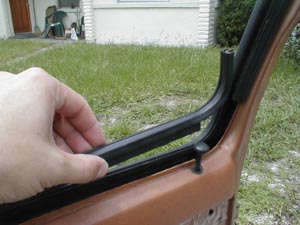
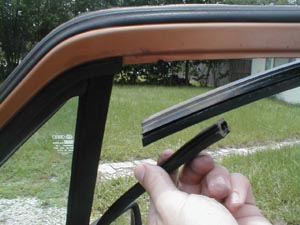
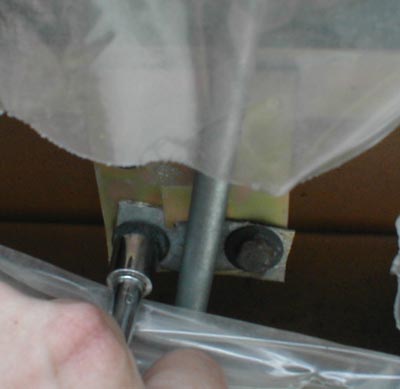
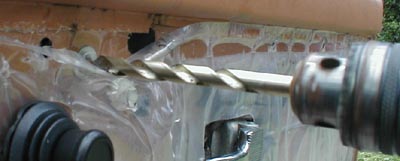 Now
we need to get rid of the rivet that holds the bottom of the vent window
in. You can actually use just a chisel and hammer to knock the head
off of the rivet instead of drilling it out like I'm doing in this picture.
Punching the rivet off with a hammer and punch is what I did in the junkyard
to get these vent widows in the first place (no electricity in the bone
yard) and it was actually quite easy. Here, I am using my drill because
I left my hammer at work (had to hammer a PC case back into shape).
No big deal to have to bust the drill out, though. You're eventually
going to need that drill to drill out the rest of the rivet so you have
a clear hole to pop a NEW rivet (or screw in a bolt) into.
Now
we need to get rid of the rivet that holds the bottom of the vent window
in. You can actually use just a chisel and hammer to knock the head
off of the rivet instead of drilling it out like I'm doing in this picture.
Punching the rivet off with a hammer and punch is what I did in the junkyard
to get these vent widows in the first place (no electricity in the bone
yard) and it was actually quite easy. Here, I am using my drill because
I left my hammer at work (had to hammer a PC case back into shape).
No big deal to have to bust the drill out, though. You're eventually
going to need that drill to drill out the rest of the rivet so you have
a clear hole to pop a NEW rivet (or screw in a bolt) into.
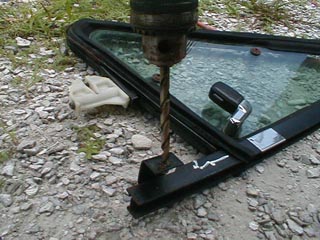
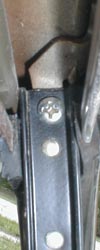 After
the head of the rivet is off, you want to remove the screw at the top of
the vent window (shown to the left). The screw is awkwardly put up
in the inner top channel of the door frame. The longer and skinnier
of a screwdriver you have, the better as to not strip out the head of the
screw. You thought that was hard to get out? Wait till we have
to put it back in! ;-)
After
the head of the rivet is off, you want to remove the screw at the top of
the vent window (shown to the left). The screw is awkwardly put up
in the inner top channel of the door frame. The longer and skinnier
of a screwdriver you have, the better as to not strip out the head of the
screw. You thought that was hard to get out? Wait till we have
to put it back in! ;-)
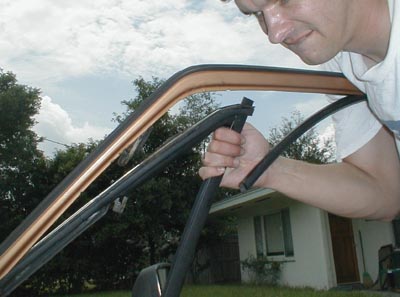
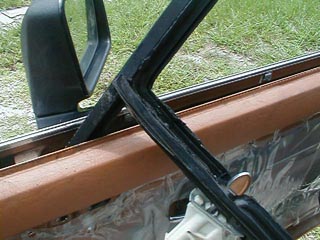
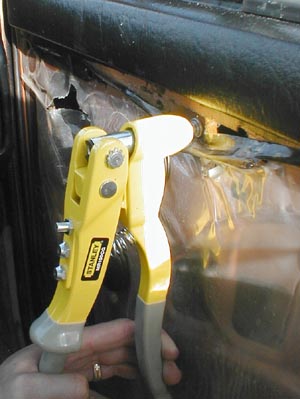 The
installation is opposite of removal. With the new vent window 90
degrees from it's to be installed position; place the vent window into
the door and rock it forward into it's "installed" position.
Work the seal around until it is properly "sealed". The window will
need a good push into the corner of the door in order to ensure that the
upper screw hole and the hole for the rivet line up. I have a rivet
gun, so I can pop a rivet in there just like VW intended, but if you do
not have a rivet gun, you can use a small bolt, although I imagine that
it's going to be pretty tough to hold a nut on the inside of the door,
on the backside of the bolt but give it a shot. Worse case scenario
is that you go buy a pop rivet gun. They're not too expensive and
a nice tool to have around.
The
installation is opposite of removal. With the new vent window 90
degrees from it's to be installed position; place the vent window into
the door and rock it forward into it's "installed" position.
Work the seal around until it is properly "sealed". The window will
need a good push into the corner of the door in order to ensure that the
upper screw hole and the hole for the rivet line up. I have a rivet
gun, so I can pop a rivet in there just like VW intended, but if you do
not have a rivet gun, you can use a small bolt, although I imagine that
it's going to be pretty tough to hold a nut on the inside of the door,
on the backside of the bolt but give it a shot. Worse case scenario
is that you go buy a pop rivet gun. They're not too expensive and
a nice tool to have around.
 After
I got a couple turns in on the screw and I couldn't yank the vent back
out of place, I switched to a regular phillips head screw driver and tightened
it down the rest of the way.
After
I got a couple turns in on the screw and I couldn't yank the vent back
out of place, I switched to a regular phillips head screw driver and tightened
it down the rest of the way.